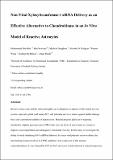| dc.contributor.author | Abu-Rub, Mohammad T. | |
| dc.contributor.author | Newland, Ben | |
| dc.contributor.author | Naughton, Michelle | |
| dc.contributor.author | Wang, Wenxin | |
| dc.contributor.author | McMahon, Siobhan | |
| dc.contributor.author | Pandit, Abhay | |
| dc.date.accessioned | 2019-08-19T14:09:57Z | |
| dc.date.available | 2019-08-19T14:09:57Z | |
| dc.date.issued | 2016-10-13 | |
| dc.identifier.citation | Abu-Rub, Mohammad T., Newland, Ben, Naughton, Michelle, Wang, Wenxin, McMahon, Siobhan, & Pandit, Abhay. (2016). Non-viral xylosyltransferase-1 siRNA delivery as an effective alternative to chondroitinase in an in vitro model of reactive astrocytes. Neuroscience, 339, 267-275. doi: https://doi.org/10.1016/j.neuroscience.2016.10.026 | en_IE |
| dc.identifier.issn | 1873-7544 | |
| dc.identifier.uri | http://hdl.handle.net/10379/15320 | |
| dc.description.abstract | Reactive astrocytosis and the subsequent glial scar is ubiquitous to injuries of the central nervous system, especially spinal cord injury (SCI) and primarily serves to protect against further damage, but is also a prominent inhibitor of regeneration. Manipulating the glial scar by targeting chondroitin sulfate proteoglycans (CSPGs) has been the focus of much study as a means to improve axon regeneration and subsequently functional recovery. In this study we investigate the ability of small interfering RNA (siRNA) delivered by a non-viral polymer vector to silence the rate limiting enzyme involved in CSPG synthesis. Gene expression of this enzyme, xylosyltransferase-1, was silenced by 65% in Neu7 astrocytes which conferred a reduced expression of CSPGs. Furthermore, conditioned medium taken from treated Neu7s, or co-culture experiments with dorsal root ganglia (DRG) showed that siRNA treatment resulted in a more permissive environment for DRG neurite outgrowth than treatment with chondroitinase ABC alone. These results indicate that there is a role for targeted siRNA therapy using polymeric vectors to facilitate regeneration of injured axons following central nervous system injury. (C) 2016 IBRO. Published by Elsevier Ltd. All rights reserved. | en_IE |
| dc.description.sponsorship | The authors would like to thank Science Foundation Ireland for financial assistance under Grant no. 07/SRC/B1163. | en_IE |
| dc.format | application/pdf | en_IE |
| dc.language.iso | en | en_IE |
| dc.publisher | Elsevier | en_IE |
| dc.relation.ispartof | Neuroscience | en |
| dc.rights | Attribution-NonCommercial-NoDerivs 3.0 Ireland | |
| dc.rights.uri | https://creativecommons.org/licenses/by-nc-nd/3.0/ie/ | |
| dc.subject | polymer | en_IE |
| dc.subject | transfection agent | en_IE |
| dc.subject | siRNA | en_IE |
| dc.subject | CSPG | en_IE |
| dc.subject | neurite outgrowth | en_IE |
| dc.subject | SPINAL-CORD-INJURY | en_IE |
| dc.subject | RESPIRATORY SYNCYTIAL VIRUS | en_IE |
| dc.subject | RNA INTERFERENCE THERAPY | en_IE |
| dc.subject | SINGLE CYCLIZED MOLECULE | en_IE |
| dc.subject | CENTRAL-NERVOUS-SYSTEM | en_IE |
| dc.subject | MULTI-VINYL MONOMERS | en_IE |
| dc.subject | SULFATE PROTEOGLYCANS | en_IE |
| dc.subject | NEURITE OUTGROWTH | en_IE |
| dc.subject | AXON GROWTH | en_IE |
| dc.subject | GENE DELIVERY | en_IE |
| dc.title | Non-viral xylosyltransferase-1 siRNA delivery as an effective alternative to chondroitinase in an in vitro model of reactive astrocytes | en_IE |
| dc.type | Article | en_IE |
| dc.date.updated | 2019-07-25T11:50:03Z | |
| dc.identifier.doi | 10.1016/j.neuroscience.2016.10.026 | |
| dc.local.publishedsource | https://doi.org/10.1016/j.neuroscience.2016.10.026 | en_IE |
| dc.description.peer-reviewed | peer-reviewed | |
| dc.contributor.funder | Science Foundation Ireland | en_IE |
| dc.internal.rssid | 11876657 | |
| dc.local.contact | Siobhan Mcmahon, Department Of Anatomy, Nui, Galway. 2838 Email: siobhan.mcmahon@nuigalway.ie | |
| dc.local.copyrightchecked | Yes | |
| dc.local.version | ACCEPTED | |
| dcterms.project | info:eu-repo/grantAgreement/SFI/SFI Strategic Research Cluster/07/SRC/B1163/IE/SRC NFB: Network of Excellence for Functional Biomaterials (NFB)/ | en_IE |
| nui.item.downloads | 336 | |


